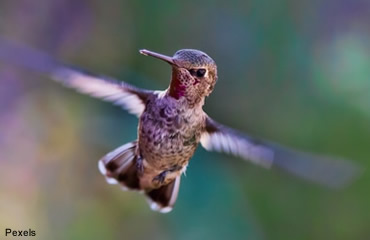It's ruby-throated hummingbird migration time! Keep those feeders clean and full of fresh nectar, enjoy the show, and help them on their journey south.
Throughout much of the eastern United States, this familiar summer resident is getting ready to leave before colder weather sets in. It’s a fast-moving flash of color, and the only hummingbird that breeds in eastern North America. You can spot them in yards, gardens, parks and woodlands from mid-April to early October.
Now that fall is nearly here, ruby-throated hummingbirds (scientific name: Archilochus colubria) begin preparing for their nonstop flight across the Gulf of Mexico. That’s a migratory distance of nearly 500 miles, which takes them between 18 and 20 hours to accomplish during good weather. Their destination is southern Mexico or northern Central America where they spend the winters.
To accomplish this tremendous migration, hummingbirds will double body mass by fattening on nectar and insects in the weeks prior to departure. They enjoy a diet of flower nectar, small insects and tree sap, and readily use hummingbird feeders.
If you use feeders, just make sure to keep them clean and full of fresh nectar.
 Ruby-throated hummers are easy to recognize. They weigh in at 11 ounces, measure about 3 3/4 inches in length, and have a wingspan about 4 1/2 inches wide. They can often be heard, between their chatter and the sound of wings beating an average of 53 times per second.
Ruby-throated hummers are easy to recognize. They weigh in at 11 ounces, measure about 3 3/4 inches in length, and have a wingspan about 4 1/2 inches wide. They can often be heard, between their chatter and the sound of wings beating an average of 53 times per second.
They have a long, thin bill and iridescent green feathers on the back. Both the male and female are white below, but males have a brilliant iridescent red gorget at their throat that can look black under certain light conditions.
Juvenile hummers, which can be seen from June to September, look like the adult female, but juvenile males often develop a few red feathers in their gorget by the end of the summer.
You may have heard one recently. Listen to a hummer’s high-pitched squeaky chatter by clicking here.
Soon after they arrive in spring, males establish territories and mate with several females, but have no further role in nesting. Females alone incubate two pea-sized eggs for 12-16 days in a walnut-sized nest made with thistle and dandelion down, and held together with spider web, and covered with lichen.
Nesting time varies from 14 to 31 days depending on the availability of food. When the young leave the nest, they are usually larger than their mothers and she will feed them for another 10 days. Sometimes nests are used or rebuilt the following year.
Sources: Tennessee Wildlife Resources Agency Watchable Wildlife. Nicholson, C. P. 1997. Atlas of Breeding Birds of Tennessee. University of Tennessee Press, Knoxville. Robinson, T. R., R. R. Sargent and M. B. Sargent. 1996. Ruby-throated Hummingbird (Archilochus colubris), The Birds of North America (A. Poole and F. Gill, eds.). The Academy of Natural Sciences, Philadelphia, Penn., and The American Ornithologists' Union, Washington, D.C. Sibley, D. A. 2000. The Sibley Guide to Birds. A. A. Knopf, New York, NY.